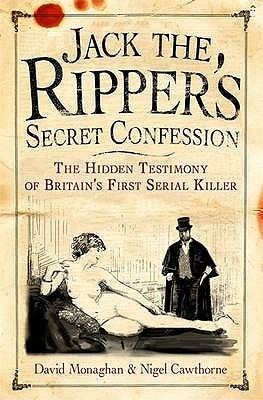Sex
Jack the Ripper's "Secret Life"
One suspect supposedly coded his fatal assaults in his erotic diary.
Posted April 2, 2014

Every year, it seems, we get a chance to reconsider the identity of Jack the Ripper from a different angle. Yet despite the claims of certain authors, I doubt we’ll ever achieve a definitive resolution to this vexing mystery.
At a 2008 conference for Ripperologists, eminent British historian Martin Fido summed it up: “When the Day of Judgment comes, and Jack the Ripper is asked to come forward and make an account, everyone else will be holding their breath, waiting, wondering, ‘Who is he?’”
I'm a sucker for Red Jack. I like to see the new theories. Some are ludicrous and many are entirely unconvincing. However, occasionally, an author presents something that no one had thought of before. That's always fun.
In a Dublin bookstore three years ago, I spotted a book that suggested yet another new suspect: The Ripper was a nineteenth-century pornographer who penned an immense amount of bawdy material under a pseudonym.
Jack the Ripper’s Secret Confession, by documentary director David Monaghan and author Nigel Cawthorne, offers the premise that “Walter,” the author of My Secret Life: The Sex Diary of a Victorian Gentleman, dropped hints throughout his works about his "Ripper" activities.
Although the publication date of this eleven-volume sexual memoir is uncertain, the authors claim it was 1888, the same year as the Ripper’s spree.
Monaghan states that after he’d seen a victim’s pain while filming a documentary, he reread Walter’s writings from a victim-centric perspective and thought that Walter's lack of empathy was similar to the 1894 confession of H. H. Holmes. [Side note: Holmes confessed for notoriety, not for the police.]
Then Monaghan spotted Walter’s description of a corpse in the Thames and sensed a veiled admission.
Reading only the abridgement that Grove Press published in 1966, one might never see a connection with the Whitechapel murders, but allegedly within the unpublished material, which is locked up in the British Library, the clues are there for the astute literary detective.
My Secret Life is a sexual autobiography of extreme cruelty, criminality, and depravity. It’s also a record of the shadows of Victorian society and evidence of Walter’s acquaintance with the type of women who fatally crossed paths with the Ripper.
The authors seem to think that Walter penned his confession in “erotic code” so he could brag about his bloody acts without being tossed in the slammer.
For the roguish Walter, it all began with a bit of clandestine peeping. Soon, he found cronies in corruption and his addictions acquired sophistication. He became a stalker, debaucher, con artist, rapist, predator, sadist, and, perhaps, a killer. For him, women were mere objects for his pleasure.
Supposedly, Walter had a powerful motive: in order to publish his racy memoir anonymously, he had to murder the witnesses (older whores) who’d procured children for him. Such women were plentiful in the streets, so he would view killing one as no real loss.
Monaghan and Cawthorne believe there is suppressed anger in Walter’s descriptions. In fact, like Bundy and others who claimed that an “entity” compelled them, Walter did describe his inner imp. Even so, that’s hardly evidence of a killer instinct. But there’s more: an absence of presence.
The authors are also suspicious of the fact that Walter never mentions the Ripper, despite mingling with prostitutes during this period of terror – as if he doesn’t want to raise any suspicion about himself. In addition, for his voyeuristic activities he used a long, thin knife to bore peeping holes into walls -- the same type of instrument used on some of the Ripper’s victims.
Thus, by weaving together a “totality of circumstances,” Monaghan and Cawthorne make their case. It’s not without significant assumptions, logical leaps, and theoretical holes, but for argument’s sake, if Walter is Jack, then to know who he is, we need only unmask the anonymous pornographer.
However, this task proves as daunting as linking any other suspect to Jack. The authors offer a list of possibilities, much like one would expect in a Ripperology text, but that’s not quite the same as revealing – at last!-- the Ripper’s identity.
We don’t learn who Walter was (and it’s not Walter Sickert, for those of you who know those long-running debates), so in the end, the premise doesn’t produce on its promise. Despite specific suggestions, there remain loose ends. Very loose.
Many serious Ripperologists will dismiss this book and perhaps even trash it, but there’s no reason not to indulge the hypothesis. I’ve seen others with less credibility gather adherents. So, let’s add “Walter” the anonymous pornographer to the list of Ripper candidates. Why not?




